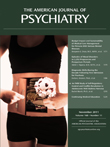Field Testing Attenuated Psychosis Syndrome Criteria
To the Editor: Attenuated psychotic symptoms that manifest before the first psychotic episode of schizophrenia are an important and challenging subject in the field of psychosis. In a commentary in the May 2011 edition of the Journal, Dr. William Carpenter and Dr. Jim van Os discussed whether or not attenuated psychosis syndrome should be a DSM-5 diagnosis (1). At issue is that the proposed diagnosis has been made only in research settings attracting ill individuals at rates disproportionate to the overall population; it is not clear whether field testing outside these settings would result in the same conversion rates.
At Parnassia Psychiatric Institute in The Hague, we recently completed a multicenter study on the implementation of a screening method for at-risk mental states in all consecutive help-seeking patients accessing community mental health services for nonpsychotic mental disorders. After screening with the Prodromal Questionnaire (2), we used the Comprehensive Assessment of At-Risk Mental States (3), a high-reliability instrument, to assess at-risk mental states.
Of 3,671 consecutive patients, we identified 52 (1.4%) with psychotic symptoms and 147 (4.0%) with at-risk mental states in whom the nontrained community mental health caretakers managing their care recognized neither psychotic states nor attenuated psychotic symptoms. Thus, these patients went undetected by the community caregivers who should in fact be among the important referrers to specialized clinical research settings. In short, these patients are missed in the traditional referral process.
On the other hand, our screening detected patients who later developed other severe psychopathology. This suggests that the at-risk group may develop multiple severe illnesses besides psychotic disorders, and it offered us the opportunity to destigmatize mental illness for them. We tell our at-risk patients that they rightly sought help because of a risk for developing severe mental illness in the future. We never mention psychosis because we have found the at-risk group to be very sensitive to the notion of psychotic syndromes. In therapy we explain how dopamine sensitization affects perception, cognitive biases, and affect, and we find that patients are less distressed by their symptoms after receiving this information.
In the future, we should develop reliable screening and detection methods with greater sensitivity and specificity in order to detect at-risk mental state populations with higher true incidences of severe illness. We recommend the nonstigmatizing name “pluripotent dopamine sensitization risk syndrome.”
1. : Should attenuated psychosis syndrome be a DSM-5 diagnosis? Am J Psychiatry 2011; 168:460–463Link, Google Scholar
2. : The Prodromal Questionnaire (PQ): preliminary validation of a self-report screening measure for prodromal and psychotic syndromes. Schizophr Res 2005; 79:117–125Crossref, Medline, Google Scholar
3. : Mapping the onset of psychosis: the Comprehensive Assessment of At-Risk Mental States. Aust NZ J Psychiatry 2005; 39:964–971Crossref, Medline, Google Scholar



